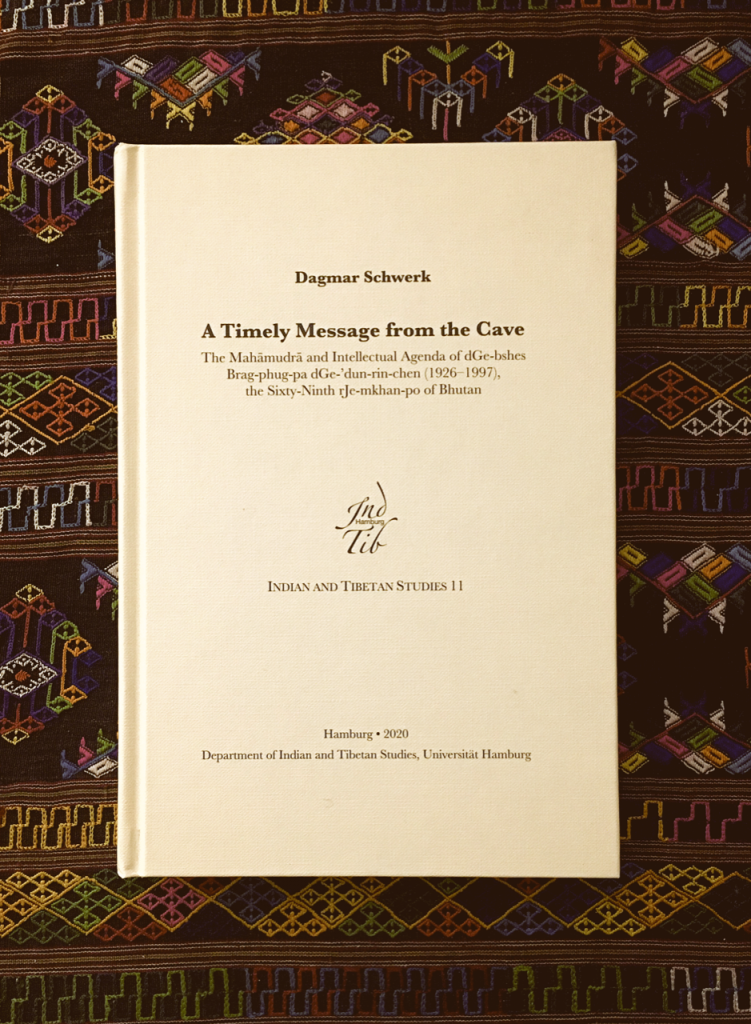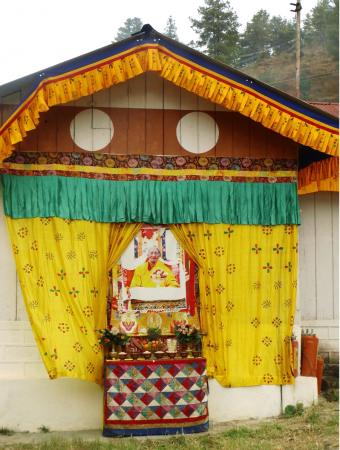Dr. Dagmar Schwerk (Khyentse Foundation Postdoctoral Fellow in Tibetan Buddhist Studies at the UBC Department of Asian Studies and UBC Himalaya Program Steering Committee Member and Buddhist Communities Liaison) recently published her monograph titled A Timely Message from the Cave: The Mahāmudrā and Intellectual Agenda of dGe-bshes Brag-phug-pa dGe-’dun-rin-chen (1926–1997), the Sixty-Ninth rJe-mkhan-po of Bhutan. We sat down with her to learn more about her monograph and the research process behind it.
1. What is your monograph A Timely Message from the Cave about, and what should people expect to find in the book?
A Timely Message from the Cave addresses the long-lasting debate about the Mahāmudrā doctrine and meditative system first elicited through Sakya Paṇḍita (1182–1251)’s systematic critique in the thirteenth century. Through my translation, the positions of eminent Bhutanese Drukpa Kagyü masters between the eighteenth and twentieth centuries are, for the first time, made accessible to an English-speaking readership. In addition, the Tibetan text corpus I worked with shows how oral discourses became new elite Buddhist textual traditions addressing Mahāmudrā and how they then gained trans-regional and trans-cultural relevance among both Tibetan and Bhutanese Buddhist masters in the eighteenth century.
As a result, the reader can expect to access one of the lesser-known and under-researched scholastic traditions, the Bhutanese Drukpa Kagyü school and their detailed interpretation of Mahāmudrā, the paramount teaching in all Kagyü schools that is today practiced globally. Remarkably, the Tibetan text corpus also deals with the entire spectrum of controversial topics crucial to Mahāmudrā. Some of those topics had been discussed for centuries, referencing earlier philosophical disputes in India. Through A Timely Message from the Cave, the reader will be introduced thoroughly to this important debate.
I also document and discuss the life and vast literary and scholastic heritage of the Sixty-ninth Chief Abbot of Bhutan, Geshe Drapukpa Gendün Rinchen (1926–1997, hereafter Je Gendün Rinchen). As an author, scholar, teacher, and practitioner, this important Buddhist master significantly contributed to the doctrinal innovations and modernization of religious educational institutions of the Drukpa Kagyü school in Bhutan in the second half of the twentieth century. Through my analysis, the reader will learn more about religious life in Bhutan in the twentieth century.
2. The title of your monograph—A Timely Message from the Cave—is very intriguing! To what does it refer?
The title actually alludes to several interesting aspects! The biographical sources about Je Gendün Rinchen report that his mother gave birth to him in a cave at Taktsang, the Tiger’s Nest, one of the most sacred sites in Bhutan. Later in his life he was admired as a specific kind of Buddhist practitioner, who performs extensive meditation retreats in caves. In the Tibetan Buddhist world, such practitioners are given the moniker “cave hermit” (Tibetan: brag phug pa). Je Gendün Rinchen’s predilection for retreat and meditation away from the everyday struggles of the world is well-documented in his autobiographical writings and works, and he strongly identified with this moniker. Second, his extensive commentary on Mahāmudrā carries the title “Timely Messenger.” It was composed to urgently clarify the misunderstandings he perceived at the time about the paramount teaching in his school. More broadly speaking, I wish to make his intellectual agenda accessible, thus the “timely message.”
3. What kinds of research and methodologies went into the book? In other words, was it mostly archival, philological or did writing this book also involve fieldwork and consulting with contemporary practitioners of Tibetan Buddhism?
My research was mainly historical-philological and text-critical including archival and field research in 2014 at the National Library and Archives of Bhutan in Thimphu. This was crucial as I was able to access Tibetan-language primary sources there that were only available in Bhutan and had not yet been translated into English. In addition, from the very beginning, my work was informed by intellectual exchange with Tibetan and Bhutanese scholars and practitioners, helping me to reference contemporary developments of religious life in the Himalayas. Such an approach was indispensable for my research. For example, specific explanations or practice instructions are not accessible through texts. Thanks to hospitality and the trust of my Bhutanese colleagues and friends, I was able to connect with key sites of Je Gendün Rinchen’s activities, birth, and eventual passing, and to meet his disciples and relatives – thereby tapping into the rich oral traditions of his life and receiving the oral transmission (Tibetan: lung) of Je Gendün Rinchen’s Timely Messenger.
In sum, A Timely Message from the Cave includes: a critical edition as an editio princeps, a richly annotated translation, and a comprehensive analysis of Je Gendün Rinchen’s dense Mahāmudrā commentary in verse, the Timely Messenger, which also comprises the root text by the Ninth Chief Abbot of Bhutan Shākya Rinchen (1710-1759), the Pointed Spear of a Siddha. My monograph also includes a colored facsimile edition of two versions of the Pointed Spear of a Siddha from the National Library and Archives of Bhutan. In addition, my work about the life and literary and scholastic heritage of Je Gendün Rinchen is based on classical Tibetan biographical and autobiographical accounts and his collected works in ten volumes.
4. Who are your intended or anticipated readers for this monograph?
Strictly speaking, A Timely Message from the Cave is intended for academic readers in the field of Buddhist studies, and in particular, Tibetan and Himalayan Buddhist studies. However, it offers interesting insights for other readers as well – Buddhist practitioners, academics from other disciplines, and the general public. I am looking forward to having inspiring conversations with you all! As my monograph is available both as an open-access e-book and in hardcover, this will hopefully be achieved!
5. What kinds of questions or conversations does A Timely Message from the Cave open up beyond Buddhist studies that would be of trans-disciplinary interest?
Some topics of trans-disciplinary interest are: trans-regional and trans-cultural knowledge exchange and text production between India, the Himalayas, and Tibet; the role of religion in constructing socio-cultural identity and nation-building; and the relationship between textuality, orality, and the media in the context of religious biographical traditions today. These topics relate to the broader fields of religious studies, literary studies, anthropology, media studies, art history, material culture studies, sociology, and political science—and, of course, Himalayan studies! Throughout my monograph, I systematically discuss and refer to such intersections.
6. Can you tell us a little about the process of turning your doctoral thesis into a monograph? This is something that many graduate students will be thinking about.
First of all, it is without a doubt a painful but also partially pleasurable process. This process is probably very individual and also depends on what graduate students plan to do professionally. However, for me, two aspects stood out that may be useful to consider.
First, it is important to identify the intended readership. My monograph benefitted immensely from having worked in two different interdisciplinary and international postdoctoral settings since my graduation (University of Leipzig and University of British Columbia). I have intentionally looked for opportunities for exchange with scholars from various fields about my work. By seeing my work through new “lenses,” I was able to question my own approach, refocus, and finally, carve out what I wanted to say! Then, I broadened the intended readership by creating points of intersection for interesting trans-disciplinary academic discourses.
Second, I have some thoughts about time and project management. Developing a realistic publication plan depends on one’s personal situation and I found it helpful to track my progress with a time- and project-management/workflow tool. Also, I planned rest times, rewarded myself for completed tasks, and regularly adjusted the plan, which was equally important. Whatever time you allocate for proof-reading/editing/typesetting, I have found that doubling this time allocation is a good idea. I learned that it is crucial to be realistic about myself and the people I work with. This will also be very beneficial for my next book project because I have built up useful experience on how much time I need for certain kinds of work. And last but not least, seeking positive feedback for completed parts really helps with exhaustion and motivation!
7. Could you share something that you learned in the process of writing A Timely Message from the Cave?
To accept and even welcome that a book is never really “complete.”
8. Lastly, do you have a favorite story or teaching from the book?
I really enjoyed reading several of Je Gendün Rinchen’s poems and “songs of realization” which are found in his autobiographical writings and collected works. They beautifully demonstrate his erudition, wit, and directness. I share here my translation of a verse from one of Je Gendün Rinchen’s poems that offers advice for a cave hermit, and is also directed towards himself. I hope to do more work on this in the future!
“If you [can] not tame your rigid mind [resembling] a bowl of [hot] oil
[How can you] tame the mind of others, you low-minded fool?
Bragging about being wise, without [properly] explicating the Dharma discourse
[Better to] conceal [your] qualities inside, cave hermit!”
—A Timely Message from the Cave, p. 87.
Book details:
Dagmar Schwerk, A Timely Message from the Cave: The Mahāmudrā and Intellectual Agenda of dGe-bshes Brag-phug-pa dGe-’dun-rin-chen (1926–1997), the Sixty-Ninth rJe-mkhan-po of Bhutan. Indian and Tibetan Studies 11. Hamburg: Department of Indian and Tibetan Studies, Universität Hamburg, 2020. ISBN: 978-3-945151-10-5.
Monograph, hardcover, xv + 425 pp., 25 pp. col. illus., 2 apps., ind., 25cm. Price: USD 59.00/open-access e-book: https://www.bibliaimpex.com
For further information, please consult the media kit: A Timely Message from the Cave – Media Kit
The research on and publication of A Timely Message from the Cave: The Mahāmudrā and Intellectual Agenda of dGe-bshes Brag-phug-pa dGe-’dun-rin-chen (1926–1997), the Sixty-Ninth rJe-mkhan-po of Bhutan (2020) were made possible through the generous support of the Khyentse Foundation, the Khyentse Center for Tibetan Buddhist Textual Scholarship (KC-TBTS) in Hamburg, The Robert H. N. Ho Family Foundation Program in Buddhist Studies, and the Studienstiftung des deutschen Volkes (German Academic Scholarship Foundation).
Interested to review this monograph for the Canadian Journal of Buddhist Studies? Click here for more information.
Please contact Dr. Dagmar Schwerk here:
https://asia.ubc.ca/profile/dagmar-schwerk/
Twitter: @DSchwerk
Photo credit: Oliver Mann
Photo description:
On the important Buddhist festival of commemorating “Buddha’s Descent from Heaven” during religious ceremonies at Je Gendün Rinchen’s last residence in Jangchenphu, Thimphu, on November 13, 2014. The photograph depicts the shrine erected at the backside of Je Gendün Rinchen’s bed-room, a crucial place of worship, as he is said to have remained there in death and postmortem meditative absorption for eleven days after his passing on April 17, 1997–a state said to only be actualized by realized Buddhist practitioners. Photo credit: Dagmar Schwerk.


